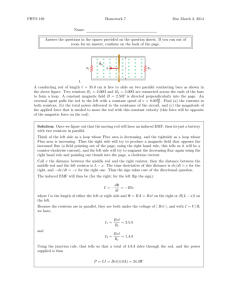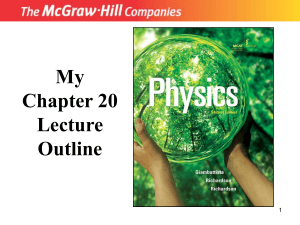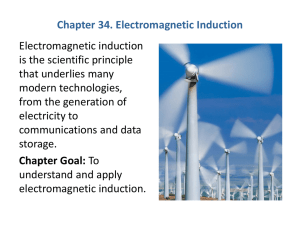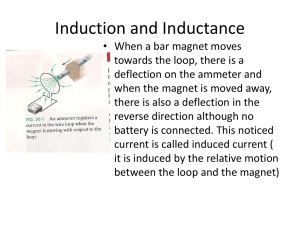CH 20 – Induced Voltages
advertisement
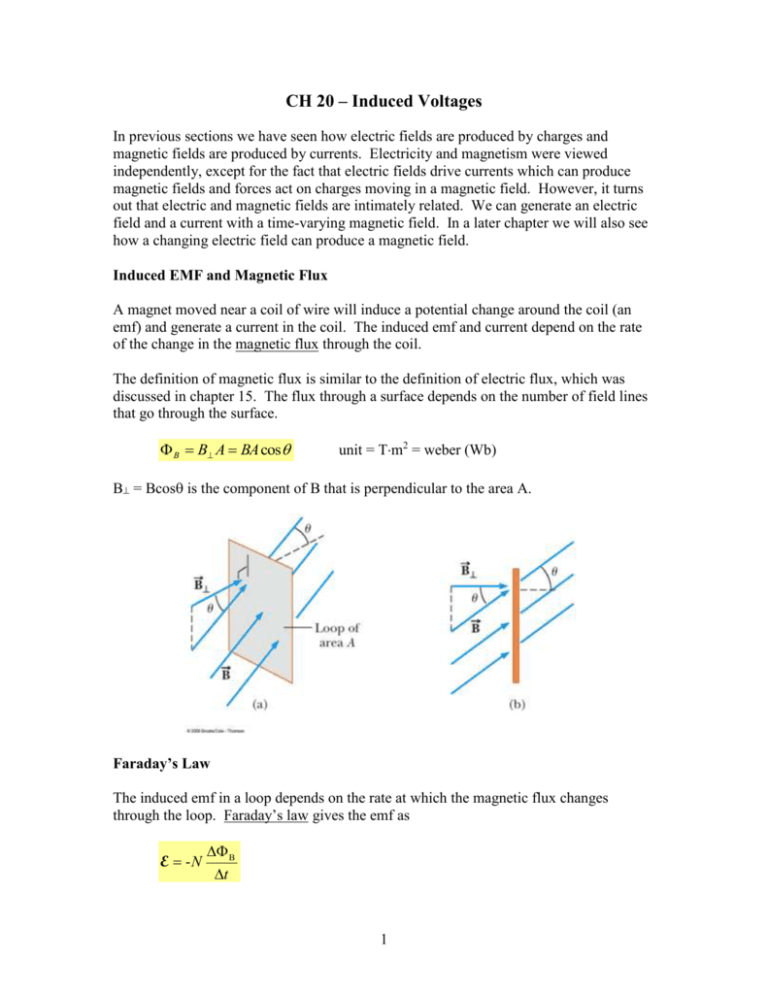
CH 20 – Induced Voltages In previous sections we have seen how electric fields are produced by charges and magnetic fields are produced by currents. Electricity and magnetism were viewed independently, except for the fact that electric fields drive currents which can produce magnetic fields and forces act on charges moving in a magnetic field. However, it turns out that electric and magnetic fields are intimately related. We can generate an electric field and a current with a time-varying magnetic field. In a later chapter we will also see how a changing electric field can produce a magnetic field. Induced EMF and Magnetic Flux A magnet moved near a coil of wire will induce a potential change around the coil (an emf) and generate a current in the coil. The induced emf and current depend on the rate of the change in the magnetic flux through the coil. The definition of magnetic flux is similar to the definition of electric flux, which was discussed in chapter 15. The flux through a surface depends on the number of field lines that go through the surface. B B A BA cos unit = Tm2 = weber (Wb) B = Bcos is the component of B that is perpendicular to the area A. Faraday’s Law The induced emf in a loop depends on the rate at which the magnetic flux changes through the loop. Faraday’s law gives the emf as E -N B t 1 where N is the number of turns of wire in the coil and t is the time during which the flux changes. Lenz’s Law The minus sign in Faraday’s law is symbolic and is determined by Lenz’s law. Lenz’s law says that the direction of the induced emf is such that any resulting induced current must be in a direction to generate a magnetic field in the loop which opposes the change in the original flux. It is important to note that it is not the magnitude or direction of the original flux that matters. It is whether this flux is increasing or decreasing and the rate at which it changes. The figure to the right illustrates how the flux in a loop can be changed by moving a bar magnet either toward or away from the loop. If there is no motion, as in (b), then there is no induced current. If you reverse the direction of the magnet, then the induced direction of the current is reversed. Example: A magnetic field points into the page, in which lies a circular coil of wire of radius 2 cm. If the field is increased from 0.5 T to 0.6 T in a time of 0.05 s. What is the average induced emf in the loop during this time? B into page and increasing Solution: B B, f B, i B f A Bi A BA (0.1T ) (0.02m) 2 1.26 x10 4 Wb |E | B 1.26 x10 4 Wb 2.51x10 3V t 0.05s 2 The direction of the induced current must be so that it produces an induced magnetic field which is out of the page and opposes the increase. For this to occur, the direction of the induced current must be counter-clockwise. If we know the resistance of the coil, then we can find out the magnitude of the induced current. For example if the resistance is R = 0.02 , then the induced current is I |E | 2.51x10 -3V 0.126A R 0.02 The flux can be changed in a coil by changing the area or the orientation of the loop in the field. For example, in the above problem we could induce a current in the loop by jerking the loop out of the magnetic field. If the loop were quickly moved to the right of the page, where the field is zero, then the flux would decrease and the induced current would be clockwise. This direction of induced current would generate a magnetic field due to the loop that points into the page and would oppose the reduction in the flux caused by moving the coil out of the original field. Example: Suppose the magnetic field in the above example was kept at 0.5 T, but the loop were flipped by 180o in a time of 0.05. What would be the induced emf? The flux would reverse direction, so the change would be twice the original value. B B , f B ,i BA BA 2 BA |E | B 2( 0.5T ) ( 0.02 )2 0.025 1V t 0.05s Motional EMF Another way to view the induced emf in a coil if we jerk it out of a field is to think of the force exerted by the field on the conduction electrons in the wire. For a single straight conducting rod moving perpendicular to a field, the force on the charges is along the direction of the rod. This force moves electrons to one end of the rod and leaves positive charge at the other end. The electrons move until the electric force generated by the displaced charge balances the magnetic force. That is, F qE qvB, or E vB 3 v F A potential difference is generated between the ends of the rod can be calculated as V E l B l v , where l is the length of the rod. If we were to connect the opposite ends of the rod with a wire, then we would have a complete circuit and current will flow. Motional emf and the induced emf described by Faraday’s law are basically different ways of looking at the same effect. Suppose the rod above were sliding along parallel rails that were connected at one end so that there was a complete circuit, as shown below. Then the area enclosed by the circuit would be increasing in time and the magnetic flux through the loop would be increasing in a direction into the page. Thus, a current would be induced in the loop in the ccw direction in order to produce an opposing flux. I v B into page and increasing Example: A Boeing 747 has a wingspan of 60 m and is flying north at 250 m/s. The earth’s magnetic field is 2.5 x 10-5 T and is directed north but below the horizon at 30o. What is the emf that is developed between the wing tips? What is the polarity of the emf? Solution: Only the vertical component of the magnetic field generates a motional emf. So, V B l v B sin( 300 ) l v ( 2.5x105 T ) sin( 300 )( 60m )( 250m / s ) 0.19 V Using the right-hand rule, the force on the positive charges in the airplane are west, to the tip of the left wing is positive and the tip of the right wing is negative. Electric generator An electric generator converts mechanical energy (motion) into electrical energy (voltage and current) and can be explained by Faraday’s law or the concept of motional emf. It works more or less like a dc motor in reverse. An applet showing how a generator works can be found at http://bama.ua.edu/~jharrell/Fendt_applets/ph14e/generator_e.htm 4 Inductance Consider the circuit below, in which you have a battery connected in series with a resistor and a coil (e.g., a solenoid). When the switch (S) is closed, the current through the coil starts to increase from zero to some final steady-state value. This changing current produces a changing magnetic field and a changing magnetic flux in the coil. According to Faraday’s law, an emf will be induced in the coil whose direction will oppose the change taking place. The polarity of the emf (a potential difference between the two ends of the coil) will be as shown in the figure. It will oppose the current that the battery is attempting to deliver to the circuit and slow its increase to its final steady-state value. If the flux in each coil is B and there are N turns in the coil, then the total flux is NB. This total flux is proportional to the current in the coil. N B LI The constant of proportionality, L, is called the ‘inductance’. L N B I unit = Wb/A = henry (H) According to Fararday’s law and the above definition of L, the emf of the inductor is given by EL N B I L t t There will only be an emf across the inductor when the current is changing. After it reaches a steady state, there will be no emf and the current in the above circuit will be 5 If E , R where E is the battery voltage. It can be shown that after the switch is closed the current increases exponentially in time, somewhat like the voltage across a capacitor as it is charged. I E (1 et / ) , R where the time constant for energizing the inductor is L R Note that the time constant for the LR circuit varies inversely with R, whereas it is proportional to R for an RC circuit ( = RC). An inductor carrying a current contains energy in the form of the magnetic field. The energy can be calculated from the power delivered by the current., P = E LI. The work done in increasing the current by I is W Pt EL I t L I It LII t The total work done to increase the current to I, which is the magnetic potential energy stored in the inductor, is PE 1 LI 2 2 The factor ½ comes from averaging the work as I increases from zero to its final value – somewhat like the ½ in the expression for the electrical energy stored in a capacitor (PE = ½ CV2) and the elastic potential energy stored in a spring (PE = ½ kx2). When you de-energize an inductor, a resistive path must exist for the current to flow to allow the energy to dissipate and the current to go to zero. The current will then decrease exponentially in time according to the equation I I 0 e t / 6 I I I0 E/R 0.63 E/R 0.368 I0 = L/R = L/R t Energizing an inductor t De-energizing an inductor Inductance of a solenoid The inductance of a solenoid can be calculated using the previously given definition of L, N B I B BA B 0 NI / L L L L N ( 0 NI / L ) A I 0 N 2 A (inductance of a solenoid) L Example: A solenoid has 100-turns of wire, a diameter of 2 cm, and a length of 5 cm. What is its inductance? L 0 N 2 A L ( 4 x 10 7 )( 100 )2 ( 0.01 )2 7.9 x10 5 H 0.05 If the current in the inductor is 2 A, what is the stored energy? PE 1 LI 2 1 ( 7.7 x10 5 )( 2 )2 1.58 x10 4 J 2 2 If this inductor is de-energized through a 50- resistor, what is the time constant? L 7.9 x10 5 1.6 x10 6 s 1.6 s R 50 7



